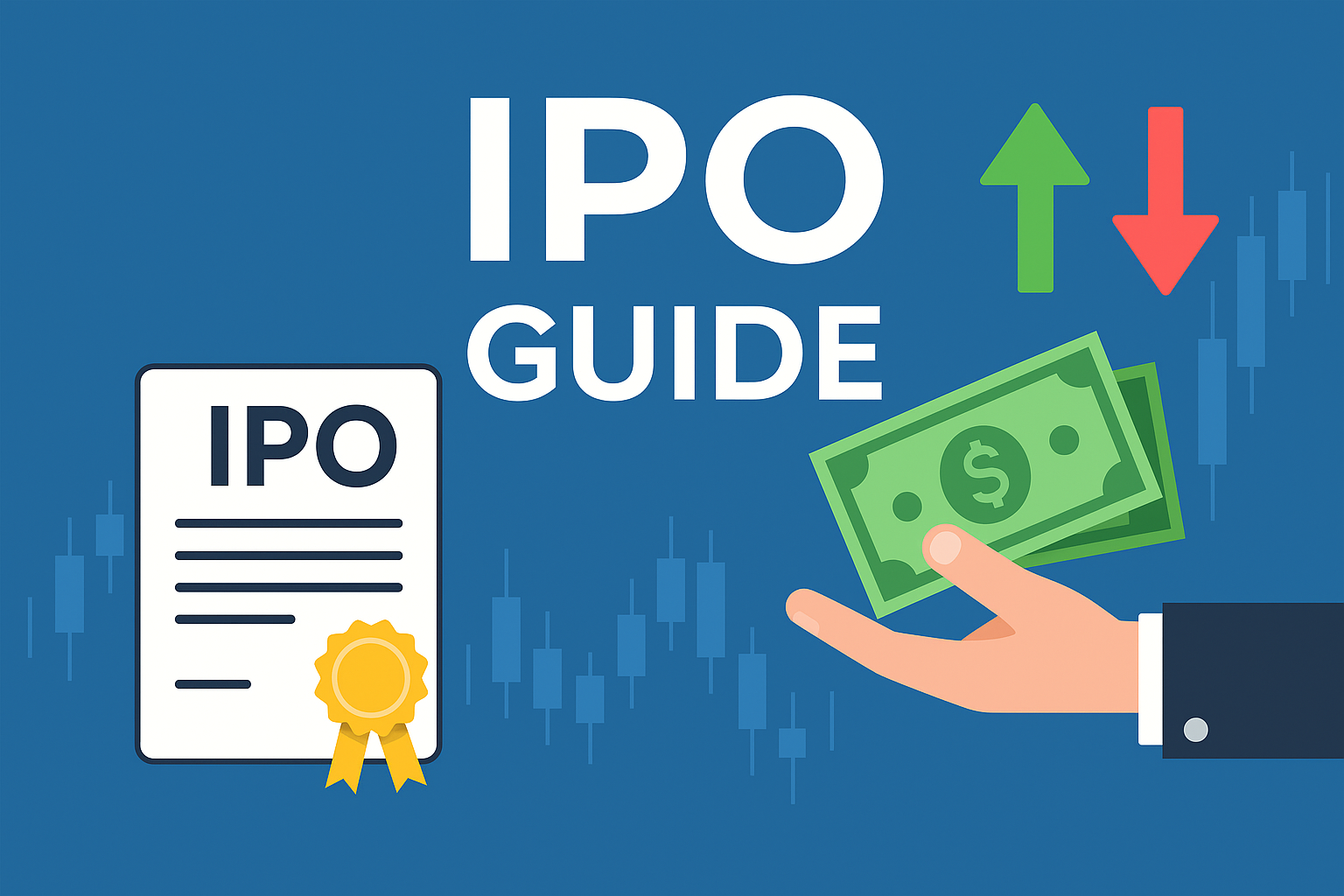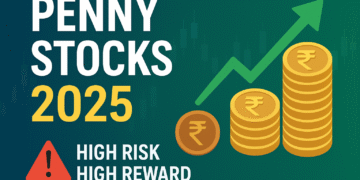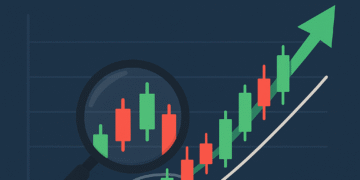The Indian stock market has seen a big increase in initial public offerings (IPOs) in recent years. Many companies are choosing to go public to raise money. In 2025, this trend is likely to keep growing, with more companies ready to debut.

When a private company first sells its stock to the public, it’s called an IPO. This lets companies get money from many investors, from small ones to big ones. But with so many IPOs out there, picking the right ones is key.
Key Takeaways
- Understand the IPO process and its benefits
- Learn how to analyze IPOs for possible investment
- Identify key factors to consider when selecting an IPO
- Discover tips for successful IPO subscription
- Avoid common mistakes when investing in IPOs
The IPO Boom in India’s Stock Market
India’s stock market has seen a big jump in Initial Public Offerings (IPOs) recently. This has caught the eye of investors all over the country. It shows that the economy is growing and investors are feeling more confident.
Current IPO Trends in 2025
In 2025, there has been a big increase in IPOs. Companies from different fields are choosing to go public. This is because the stock market is doing well, making it a good time for companies to raise money.
Key Trends:
- More industries are getting involved
- IPO sizes are getting bigger, with both big and small companies going public
- More retail investors are showing interest
Why IPOs Have Become a Hot Investment Trend
IPOs are now a favorite among investors because they can offer big returns. People are attracted to IPOs because they get to be part of a company’s growth story early on.
| Reasons for IPO Popularity | Description |
|---|---|
| Potential for High Returns | IPOs can lead to big gains if the company does well after listing. |
| Early Access | Investing in an IPO lets you get in on a company’s growth early. |
| Diversification | IPOs can help investors diversify their portfolios. |
As the IPO market keeps changing, it’s key for investors to keep up with the latest trends and strategies. Knowing the ipo investing strategy india and deciding if you should invest in ipos are important steps in making smart investment choices.
Watching the ipo performance in indian stock market can give useful insights into the success of future IPOs.
Understanding Initial Public Offerings
Initial Public Offerings (IPOs) are a big step for companies. They move from being private to public. This lets companies get money from many investors, helping them grow and be seen more in the market.
What Exactly Is an IPO?
An Initial Public Offerings (IPO) is when a private company first sells stocks to the public. It lists its shares on a stock exchange. This way, the company gets money from public investors for things like growing, paying off debts, or starting new projects.
The IPO process involves many people like investment banks, lawyers, and regulators. It’s a detailed process that needs careful planning and follows strict rules.
The IPO Process in Indian Markets
In India, the IPO process is watched over by the Securities and Exchange Board of India (SEBI). Companies wanting to go public must send a Draft Red Herring Prospectus (DRHP) to SEBI. This document has all about the company’s money, business, team, and how they plan to use the IPO money.
After SEBI says it’s okay, the company sets a price for the shares. Then, the public can buy shares for a set time. If more people want shares than there are, the company uses a lottery to decide who gets them.

Why Companies Choose to Go Public
Companies go public for many reasons. One big reason is to get money to grow. An IPO lets them get a lot of funds for new projects, expanding, or paying off debts.
Going public also makes a company more visible and trusted. Being on a stock exchange means they have to be open and honest. This can make them more appealing to customers, suppliers, and partners.
Also, an IPO lets early investors and employees sell their shares. This gives them a chance to make money back. This is a big plus for venture capitalists and early investors.
The Complete IPO Investing Guide for India 2025
India’s economy is growing fast, and the IPO market is expected to boom in 2025. To make the most of this, investors need to understand the IPO scene well. This includes knowing the market outlook, regulatory changes, and the differences between primary and secondary markets.
IPO Market Outlook for Indian Investors
More companies are planning to go public as the market grows. India’s economy and investor confidence are on the rise. Investors should watch sectors like technology and renewable energy, as they might lead in IPOs.
The outlook for IPOs in India looks good, thanks to several factors. A stable government, more foreign investment, and a growing middle class are key. Also, online platforms have made it simpler for retail investors to join IPOs.
Regulatory Framework and Recent Changes
The rules for IPOs in India have changed a lot recently. The Securities and Exchange Board of India (SEBI) has brought in reforms to make things clearer and safer for investors. One big change is the Disclosure-based framework, which asks companies to share more about their finances and operations.
SEBI has also worked to stop speculation and ensure fair prices. For example, companies now have to share how they set their IPO prices and value. This helps protect investors from overpriced IPOs and ensures companies are honest about their state.
Primary vs. Secondary Market Investing
Investors often wonder if they should buy into IPOs or listed companies. IPOs can offer big gains if you pick companies that are undervalued but have growth chances. But, they also come with risks because of less data and possible overpricing.
Buying shares in the secondary market means investing in companies that are already listed. This market has more data and is easier to handle, thanks to its liquidity. A smart strategy for 2025 might be to mix both primary and secondary market investments.
Essential Factors to Analyze Before Investing in an IPO
Before investing in an IPO, it’s key to understand the important factors. This helps reduce risks and increase gains. Look beyond the excitement and focus on the company’s true value.
Company Fundamentals: Revenue and Profit Growth
Checking a company’s revenue and profit growth is vital. Look for steady growth, reliable income, and good profit margins. These signs show a strong and lasting business.
- Review historical financial data to identify trends and growth patterns.
- Assess the company’s revenue streams and their sustainability.
- Evaluate profit margins in comparison to industry averages.
Debt Levels and Financial Health Indicators
Understanding a company’s debt and financial health is important. It shows if the company can handle tough times. Look at debt-to-equity ratios, interest coverage ratios, and cash flow statements.
- Examine the debt-to-equity ratio to understand the company’s leverage.
- Assess the interest coverage ratio to evaluate the company’s ability to service its debt.
- Review cash flow statements to ensure the company has sufficient liquidity.
Business Model Sustainability
The long-term success of a company depends on its business model. Investors should check the company’s competitive edge, market standing, and growth chances.
Key considerations include:
- The company’s competitive advantage and market differentiation.
- Potential disruptions to the business model from technological or regulatory changes.
- The company’s ability to adapt to changing market conditions.

By examining these key factors, investors can make better choices. It’s also wise to keep up with market and regulatory changes that might affect the IPO.
Evaluating Industry IPO Success
When it comes to Initial Public Offerings (IPOs), the industry’s growth matters a lot. Investors look at the sector’s future and how it stacks up against others. This helps them decide if an IPO is worth their money.
Sector Growth Prospects in the Indian Economy
The Indian economy has many sectors, each with its own growth chances. For example, tech, healthcare, and green energy are booming. The tech sector, with its focus on AI and cybersecurity, is growing fast.
To spot IPOs with great growth, look at market size, demand, and competition. A sector with high demand and limited supply is more promising.
Competitive Landscape Analysis
Knowing who you’re up against is key to judging an IPO’s chances. This means checking the market share, financial health, and strategies of major players. For example, in e-commerce, Flipkart and Amazon are big names.
An IPO from a smaller player needs to stand out to succeed. A deep dive into the competitive scene helps investors see if an IPO can grab market share and last long.
Government Policies and Sector Outlook
Government policies can really shape a sector’s future. For instance, green energy policies can boost IPOs in that field. Keeping up with regulatory changes and government plans is important.
Also, understanding long-term trends, tech advancements, and changes in consumer behavior is key. This helps investors make smart choices about IPOs.
Valuation Metrics: Is the IPO Fairly Priced?
Figuring out if an IPO is worth the price is key for investors. It’s a tough task, even for big banks. So, it’s important to know the different ways to check if an IPO is priced right.

Price-to-Earnings Ratio Comparison
The price-to-earnings (P/E) ratio is a key tool for IPO valuation. It shows how much you pay for each share compared to the company’s earnings. By comparing this ratio to similar companies, you can tell if the IPO is too expensive or not.
For example, if the average P/E ratio of similar companies is 20, but the IPO’s is 30, it might be overvalued. On the other hand, a lower P/E ratio could mean the IPO is a good deal.
Comparing Valuations with Listed Peers
Looking at how the IPO compares to its listed peers gives valuable insights. This comparison should consider growth, industry trends, and market conditions.
It’s important to check the financial health, business model, and competitive edge of both the IPO and its peers. This detailed look helps figure out if the IPO is fairly priced compared to others.
Identifying Overpriced IPOs in Indian Markets
Spotting overpriced IPOs is vital to avoid losses. These can be due to hype, market mood, or unrealistic growth hopes. Investors should watch out for IPOs priced too high compared to their true value.
To spot overpriced IPOs, look at the P/E ratio, price-to-book ratio, and enterprise value-to-EBITDA ratio. Analyzing these, along with understanding market trends and company basics, helps investors decide wisely about IPOs.
In summary, checking an IPO’s valuation is a key part of investing. By using these metrics, investors can tell if an IPO is fairly priced. This helps make better choices in the Indian IPO market.
Assessing the Management and Promoter Background
Looking into a company’s management and promoter background is key to judging its IPO success. A good team and background can greatly influence a company’s success.
Promoter Track Record and Reputation
The promoter’s past and reputation are very important. Investors should check the promoter’s history and their skills in managing the company.
A promoter with a good track record is more likely to lead the company to success. For example, Infosys has a respected promoter and a history of success.
“A strong promoter can make all the difference in a company’s success.” –
R. Seshasayee, Chairman, IIM Ahmedabad
Management Team Experience and Credibility
The experience and credibility of the management team are also important. A team with a proven track record and relevant experience can boost the company’s chances.
| Company | Management Team Experience | IPO Performance |
|---|---|---|
| Company A | 10+ years | Strong |
| Company B | 5 years | Average |
| Company C | 15+ years | Excellent |
Corporate Governance Standards
Corporate governance standards are vital for responsible and ethical management. Investors should look for companies with a strong board, transparent reporting, and a clear audit committee.
By examining the management and promoter background, investors can learn a lot about the company’s future. This, along with financial health and industry prospects, helps make informed choices.
Understanding Grey Market Premium in IPO Investing
Knowing about the grey market premium is key for smart IPO investing. The grey market premium (GMP) is the IPO share price in the grey market before the official listing. It shows how much investors are willing to pay before the shares are listed.
What Grey Market Premium Indicates About Market Sentiment
The GMP shows what investors think about an IPO. A high GMP means investors are hopeful about the IPO’s future. They’re willing to pay more for shares before they’re listed.
Key factors influencing GMP include:
- Company fundamentals and growth prospects
- Industry trends and sector outlook
- Overall market conditions and investor sentiment
A study by a leading financial research firm found that IPOs with a high GMP tend to do well short-term. But, this doesn’t always mean they’ll succeed long-term.
“The grey market premium is a barometer of investor enthusiasm, but it should not be the sole criterion for investment decisions.” – Financial Analyst
Limitations of GMP as an Investment Indicator
While GMP gives insights into market sentiment, it has its limits. The grey market is not regulated, leading to volatile prices. These prices can be influenced by a few investors.
| Limitations of GMP | Description |
|---|---|
| Lack of Regulation | The grey market operates outside the purview of regulatory bodies, making it susceptible to manipulation. |
| Volatility | GMP can fluctuate rapidly based on market rumors and sentiment. |
| Limited Transparency | Information about grey market transactions may not always be accurate or up-to-date. |
Using GMP Data Wisely in Your Investment Decision
To use GMP data well, investors should look at it with other analysis tools.
Here are some strategies:
- Compare GMP with the IPO’s issue price to gauge market enthusiasm.
- Analyze the trend of GMP over time to understand shifting investor sentiment.
- Use GMP in conjunction with other valuation metrics to get a complete view of the IPO’s value.

By understanding and using GMP data wisely, investors can make better choices in IPO investing.
Major Risks in IPO Investing You Should Know
IPO investing comes with big risks that can hurt your returns. It’s key to know these risks. IPOs can lead to big gains but also face unique challenges.
Overhyped Valuations and Market Sentiment
One big risk is overhyped valuations. When everyone is too optimistic, IPO prices can soar too high. This can lead to a big drop after listing. Watch out for IPOs with prices that don’t match their financials.
Market mood greatly affects IPO prices. Grey market premiums and high demand can signal hype. It’s vital to tell real growth from just hype.
Post-Listing Volatility Patterns
After listing, IPOs can see big price swings. This can lead to big losses if the price doesn’t match the company’s true value. Knowing what causes this volatility helps investors make better choices.
Looking at post-listing volatility patterns of other IPOs can offer clues. This helps investors understand the risks and chances of an IPO.
Limited Historical Data for Analysis
IPOs have less history to study than established companies. This makes it hard to predict their future and financial health.
To lessen this risk, look at the company’s business model sustainability, management team credibility, and industry outlook. While past data is useful, future signs are also key to seeing growth and profit chances.
When to Subscribe to an IPO: Clear Indicators
Success in IPO investing comes from knowing the right signs. Look for strong company basics, fair prices, and growth chances.
Strong Fundamentals Worth Investing In
A company with solid basics usually does well after going public. Key signs include:
- Revenue Growth: A steady rise in sales over time.
- Profitability: The company should show profits or be on track to do so.
- Financial Health: Low debt and good cash flow.

Fair Valuation Relative to Industry
Valuation is key to deciding if an IPO is a good buy. Compare the IPO’s prices with those of similar companies.
| Valuation Metric | IPO Company | Industry Average |
|---|---|---|
| Price-to-Earnings Ratio | 20 | 25 |
| Price-to-Sales Ratio | 3 | 4 |
Growth Sector with Long-term Potencial
Investing in IPOs from growing sectors can be very rewarding. Sectors like tech, healthcare, and green energy often promise big future gains.
For example, a tech company with new products can offer big growth chances.
By paying attention to these signs, investors can make better choices about when to buy into an IPO.
When to Avoid an IPO: Red Flags for Investors
When looking at an IPO, it’s key to watch for warning signs. These signs can tell you if an IPO is risky. Investors need to be careful of certain signs that might mean the IPO is not a smart choice.
Weak Financial Performance and Inconsistent Growth
A company’s financial health is very important when thinking about an IPO. Look closely at the company’s revenue growth, profit margins, and cash flow. Weak financial performance and uneven growth are big warning signs.
For example, if a company’s sales have been going down or its profits are getting smaller, it might have big problems. Also, if the company’s earnings are all over the place, it’s hard to guess what will happen next.
Excessive Pricing Compared to Peers
Valuation is another key thing to think about with an IPO. Check how the IPO’s price compares to its competitors. Excessive pricing compared to others can mean the IPO is too expensive.
| Company | Price-to-Earnings Ratio |
|---|---|
| Company A | 25 |
| Company B (IPO) | 40 |
| Industry Average | 30 |
In this example, Company B’s IPO is much pricier than its rivals. This suggests it might be overvalued.
Lack of Competitive Advantage in the Market
A company’s edge in the market is key to its success. Check if the company has something unique, a strong brand, or a big share of the market. Without a strong edge, it’s hard for a company to stay ahead.
For instance, if a company is in a very competitive field with easy entry, it might lose its place. Also, if its product or service doesn’t stand out, it could lose customers.
Knowing these warning signs helps investors make better choices about IPOs. Always do your homework and research well to avoid risks.
Practical IPO Subscription Tips for Indian Investors
Understanding practical tips is key to successful IPO investing in India. The IPO market is getting more competitive. Investors need strategies to boost their chances of getting shares.
Application Strategies for Better Allotment Chances
Using the right application strategy can help increase allotment chances. Investors can apply online, through mobile apps, or on the stock exchange’s platform. It’s important to fill out the application correctly and submit it on time.
Applying through multiple methods can also help. For example, applying online and through the stock exchange can make you more visible. But, applying through the same method more than once can lead to disqualification.
Using Multiple Demat Accounts Effectively
Using multiple Demat accounts can increase allotment chances. By applying through different accounts, you can get noticed more. But, make sure all applications follow the rules and you understand the consolidated account statement implications.
Investors should also watch out for the risk of over-subscription. Make sure your applications match your investment goals and financial situation.
Timing Your Application During the Subscription Period
The timing of your IPO application matters. While allotment is random, applying early or late can have different effects. Some prefer early to avoid technical issues, while others wait to see market sentiment.

The Grey Market Premium (GMP) can also influence decisions. A high GMP suggests strong demand and possible listing gains. But, don’t rely only on GMP. Always do thorough research before investing.
Conclusion: Building a Balanced Approach to IPO Investing
Investing in IPOs can be very profitable, but it needs careful planning. A good strategy for IPO investing includes thorough analysis and avoiding hype. It’s also important to think about the company’s long-term growth.
Before you decide to invest, ask yourself if the IPO is overhyped or has weak finances. A good guide should help you spot warning signs and make smart choices. By taking a balanced approach, you can handle the challenges of IPO investing and find success in the Indian stock market.
Success in IPO investing comes from being well-informed and cautious. Stay up to date, be careful, and make the most of what the IPO market offers.
FAQ
What is an IPO, and how does it work in India?
An Initial Public Offer (IPO) is when a private company first sells stock to the public. This stock is listed on a stock exchange. In India, companies list on exchanges like the National Stock Exchange (NSE) or Bombay Stock Exchange (BSE). They follow rules set by the Securities and Exchange Board of India (SEBI).
How do I analyze an IPO before investing?
To analyze an IPO, look at the company’s financials. Check revenue growth, profit margins, and debt levels. Also, see if the business model is sustainable.Examine the industry’s growth, the management team, and the background of the promoters. Look at valuation metrics like the price-to-earnings ratio. Compare it with other listed companies.
What are the risks associated with IPO investing?
IPO investing has risks like overvalued stocks and volatility after listing. There’s also limited data to analyze. Be careful of weak financials, high prices, and a lack of market advantage.
How can I subscribe to an IPO effectively?
To subscribe to an IPO well, apply through multiple demat accounts. Time your application right during the subscription period. Know the allotment process.Make sure you have enough money in your demat account. Follow the application process through platforms like ASBA (Applications Supported by Blocked Amount).
What is Grey Market Premium, and how reliable is it?
Grey Market Premium (GMP) is the unofficial price of an IPO before it lists. It shows market sentiment. But, it’s not reliable for making investment decisions because it’s unofficial and can be manipulated.
What are the key factors to consider when evaluating an IPO’s valuation?
When checking an IPO’s valuation, look at the price-to-earnings ratio. Compare it with similar companies in the industry. Be wary of overpriced IPOs.See if the valuation matches the company’s growth and financial health.
How do government policies impact IPO success?
Government policies can greatly affect IPO success, mainly in sectors influenced by changes or initiatives. Check the sector’s growth and how policies might impact the company’s future.
Should I invest in IPOs, and what is the best strategy?
Investing in IPOs can be good if you research well and are balanced. Look for companies with strong fundamentals, fair prices, and growth. Avoid IPOs with weak finances, high prices, or no competitive edge.
What is the difference between primary and secondary market investing?
Primary market investing means buying shares directly from the company during an IPO. Secondary market investing means buying from existing investors on the stock exchange. Primary market offers the IPO price, while secondary market has market-driven prices.
How do I stay updated on upcoming IPOs in India?
To keep up with IPOs, follow financial news, SEBI announcements, and stock exchange updates. Use financial platforms for IPO alerts and new listing updates.









